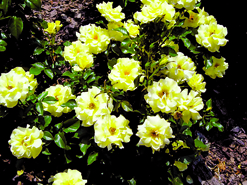The treasured rose plant’s elegant flowers hold a special place in the hearts and minds of people everywhere, says University of Missouri Extension horticulturist David Trinklein.
Roses’ beauty peaks in June at Missouri’s latitude, bringing mid-year gardening joy, he says.
Cultivation of roses likely began in Asia about 5,000 years ago, Trinklein says, and they have been an intimate part of human civilization ever since. Confucius wrote about growing roses around 500 B.C. During the Han dynasty, China devoted so much land to growing roses that it threatened the food supply. Centuries later, Roman emperors filled their baths with rose water and sat on carpets of rose petals for feasts.

In 17th-century Europe, commoners used roses and rose water as legal tender to pay debts owed to royalty. Napoleon Bonaparte’s wife, Josephine, a lover of roses, established a collection of more than 250 rose varieties in the Chateau de Malmaison gardens outside Paris.
Most of the roses in Josephine’s garden likely were of the European/Mediterranean type, Trinklein says. The China group was not introduced into Europe until the late 18th century. Shortly thereafter, hybridizers crossed the China rose (Rosa chinensis) with Rosa gigantean, a European/Mediterranean type, to form a new rose. Some thought the newly opened flowers of the cross smelled like an exquisite cup of tea, so it was given the name tea rose.
Decades later, breeders developed another type of rose by crossing various rose species with Damask rose, a hybrid from the Middle East. The offspring of these crosses rebloomed freely, earning them the name of hybrid perpetuals.
In the mid-19th century, breeders crossed tea roses with hybrid perpetuals to create the modern hybrid tea rose, the most popular type of rose in the world today. The plants bear glossy, green foliage and large flowers available in a palette of colors. “Most consider them to be the standard of excellence by which all other types of roses are judged,” says Trinklein.
Several species of rose grow indigenously in North America, and colonists brought additional species with them. William Penn imported 18 rose bushes from England. George Washington planted roses at Mount Vernon and Thomas Jefferson grew them at Monticello. John Adams is credited with planting the first rose at the White House. Woodrow Wilson established the formal White House Rose Garden, the site of many presidential news conferences and ceremonial events.
The American Rose Society lists more than 40 type of roses in its classification system. Generally, they are grouped into Old Garden Roses (introduced before 1867) and Modern Roses (developed after 1867). Important classes within the latter group include polyantha, floribunda and grandiflora.
Polyantha roses are shrubby, low-growing hardy roses with clusters of small flowers that bloom throughout the growing season.
Floribundas result from crosses between hybrid tea and polyanthus roses. They produce large, hardy, shrubby bushes that bloom profusely with clusters of flowers.
Grandiflora roses came from crossing floribundas with hybrid tea roses. Like floribunda, they produce flowers in clusters, but the plants are much larger, favoring their hybrid tea parent in size.
“Rose lineage is quite complex,” Trinklein says. “Over the centuries breeders have attempted to produce the ideal rose. In spite of all the improvements, rose still presents formidable challenges to the gardener because of its susceptibility to diseases and cold temperatures.”
The MU Extension guide “Roses: Care After Planting” is available for free download at extension.missouri.edu/G6601.
Roses are in their summer glory at Chance Gardens in Centralia, Mo. It is open to the public during daylight hours 365 days a year. Photo by David Trinklein.



Facebook Comments